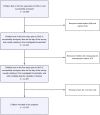Effects of the level of household access to water, sanitation and hygiene on the nutritional status of children under five, Benin
- PMID: 37528455
- PMCID: PMC10391820
- DOI: 10.1186/s40795-023-00751-8
Effects of the level of household access to water, sanitation and hygiene on the nutritional status of children under five, Benin
Abstract
Background: Whether or not the Water, Sanitation and Hygiene (WASH) conditions in which children under five live determine their nutritional status is still under discussion. The work aimed to study the effects of household WASH conditions to which children under five are exposed on their nutritional status in Benin.
Methods: The study utilized a cross-sectional design and consisted of secondary analyses using datasets from the fifth Demographic and Health Survey (DHS-V) conducted in Benin. Stunting, wasting and underweight were the dependent variables. The WASH conditions in which children live were evaluated in the immediate environment, i.e., at the level of their households. After describing the study variables, the relationships between the dependent variables and the exposures were checked using multivariate logistic regression. Data analysis was performed with Stata 15 and took into account the survey's sampling design.
Results: The prevalence of stunting, wasting and underweight was 31.15% (95% CI = 29.90-32.42), 4.79% (95% CI = 4.33-5.31) and 15.82% (95% CI = 14.92-16.76), respectively. The stunting odds were 1.35 (95% CI = 1.15-1.59) and 1.27 (95% CI = 1.01-1.59) times higher for children from households with no water and sanitation services, respectively, compared to children living in households with basic water and sanitation services. Children under five from households with no hygiene facilities and using limited hygiene services had 1.31 (95% CI = 1.05-1.63) and 1.35 (95% CI = 1.10-1.67) times the odds of being stunted, respectively, compared to children covered by basic hygiene facilities. There is no evidence of a significant relationship between household access to WASH and wasting in children under five. The odds of being underweight were 1.33 (95% CI = 1.02-1.72) times higher among children under five from households with limited hygiene facilities than among children from households with basic hygiene facilities.
Conclusion: Interventions to fight malnutrition in children under five should include a WASH dimension.
Keywords: Benin; Child; DHS; Hygiene; Sanitation; Stunting; Underweight; WASH; Wasting; Water.
© 2023. The Author(s).
Conflict of interest statement
The authors declare no competing interests.
Figures




Similar articles
-
Effects of household access to water, sanitation, and hygiene services on under-five mortality in Sub-Saharan Africa.Front Public Health. 2023 Apr 27;11:1136299. doi: 10.3389/fpubh.2023.1136299. eCollection 2023. Front Public Health. 2023. PMID: 37181724 Free PMC article.
-
Exploring the association between household access to water, sanitation and hygiene (WASH) services and common childhood diseases using data from the 2017-2018 Demographic and Health Survey in Benin: focus on diarrhoea and acute respiratory infection.BMJ Open. 2023 Sep 19;13(9):e074332. doi: 10.1136/bmjopen-2023-074332. BMJ Open. 2023. PMID: 37730407 Free PMC article.
-
Association between water, sanitation and hygiene (WASH) and child undernutrition in Ethiopia: a hierarchical approach.BMC Public Health. 2022 Oct 19;22(1):1943. doi: 10.1186/s12889-022-14309-z. BMC Public Health. 2022. PMID: 36261797 Free PMC article.
-
Water, sanitation, and hygiene vulnerability in child stunting in developing countries: a systematic review with meta-analysis.Public Health. 2023 Jun;219:117-123. doi: 10.1016/j.puhe.2023.03.024. Epub 2023 May 7. Public Health. 2023. PMID: 37159976
-
Outcome evaluation of WASH intervention in rural households at Jawi district, Northwest Ethiopia: Mixed method design, goal based evaluation.Eval Program Plann. 2023 Jun;98:102283. doi: 10.1016/j.evalprogplan.2023.102283. Epub 2023 Apr 7. Eval Program Plann. 2023. PMID: 37084492 Review.
Cited by
-
Gut microbiota differences in stunted and normal-lenght children aged 36-45 months in East Nusa Tenggara, Indonesia.PLoS One. 2024 Mar 29;19(3):e0299349. doi: 10.1371/journal.pone.0299349. eCollection 2024. PLoS One. 2024. PMID: 38551926 Free PMC article.
-
Understanding Households' Willingness to Pay for Improved Sanitation Services in Benin: A Study Protocol.Environ Health Insights. 2024 Feb 4;18:11786302241228954. doi: 10.1177/11786302241228954. eCollection 2024. Environ Health Insights. 2024. PMID: 38323117 Free PMC article.
-
Factors associated with childhood undernutrition in poor Ethiopian households: Implications for public health interventions.PLoS One. 2025 May 9;20(5):e0323332. doi: 10.1371/journal.pone.0323332. eCollection 2025. PLoS One. 2025. PMID: 40343964 Free PMC article.
-
Social determinants of health associated with increased prevalence of childhood malnutrition in Africa.Front Nutr. 2024 Nov 1;11:1456089. doi: 10.3389/fnut.2024.1456089. eCollection 2024. Front Nutr. 2024. PMID: 39555195 Free PMC article.
References
-
- World Health Organization. Fact sheets - Malnutrition. 2021. https://www.who.int/news-room/fact-sheets/detail/malnutrition. Accessed 5 Jan 2022.
-
- World Health Organization. Underweight among children under 5 years of age (number in millions) (JME). 2022. https://www.who.int/data/gho/data/indicators/indicator-details/GHO/gho-j.... Accessed 29 Mar 2022.
-
- United Nations Children’s Fund, World Health Organization . World Bank. Levels and trends in child malnutrition. Geneva, Switzerland: WHO; 2021.
LinkOut - more resources
Full Text Sources
